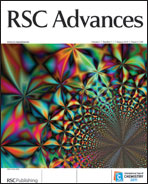Photoluminescence enhancement of Eu3+ by energy transfer from Bi2+ to Eu3+ in bismuth glass nanocomposites
Abstract
Bi2+-enhanced photoluminescence of Eu3+ doped Bi0-bismuth glass nanocomposites are demonstrated here. The generation of bismuth


 Please wait while we load your content...
Please wait while we load your content...